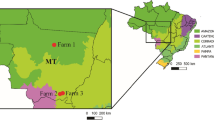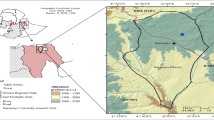Abstract
As root water uptake (RWU) is an important link in the water and heat exchange between plants and ambient air, improving its parameterization is key to enhancing the performance of land surface model simulations. Although different types of RWU functions have been adopted in land surface models, there is no evidence as to which scheme most applicable to maize farmland ecosystems. Based on the 2007–09 data collected at the farmland ecosystem field station in Jinzhou, the RWU function in the Common Land Model (CoLM) was optimized with scheme options in light of factors determining whether roots absorb water from a certain soil layer (Wx) and whether the baseline cumulative root efficiency required for maximum plant transpiration (Wc) is reached. The sensibility of the parameters of the optimization scheme was investigated, and then the effects of the optimized RWU function on water and heat flux simulation were evaluated. The results indicate that the model simulation was not sensitive to Wx but was significantly impacted by Wc. With the original model, soil humidity was somewhat underestimated for precipitation-free days; soil temperature was simulated with obvious interannual and seasonal differences and remarkable underestimations for the maize late-growth stage; and sensible and latent heat fluxes were overestimated and underestimated, respectively, for years with relatively less precipitation, and both were simulated with high accuracy for years with relatively more precipitation. The optimized RWU process resulted in a significant improvement of CoLM’s performance in simulating soil humidity, temperature, sensible heat, and latent heat, for dry years. In conclusion, the optimized RWU scheme available for the CoLM model is applicable to the simulation of water and heat flux for maize farmland ecosystems in arid areas.
Similar content being viewed by others
References
Baker, I. T., L. Prihodko, A. S. Denning, et al., 2008: Seasonal drought stress in the Amazon: Reconciling models and observations. J. Geophys. Res., 113, doi: 10.1029/2007JG000644.
Cai, F., G. S. Zhou, R. P. Li, et al., 2011: Dynamic characteristics of land surface parameters of rainfed maize fields in Northeast China. Chinese J. Ecology, 30, 494–501. (in Chinese)
Cai, F., G. S. Zhou, H. Q. Ming, et al., 2012: A simulative study of effects of dynamic parameterization of surface albedo on land–atmosphere flux exchanges: A case study of rainfed maize field in Northeast China. Acta Meteor. Sinica, 70, 1149–1164. (in Chinese)
Cai, F., H. Q. Ming, R. P. Ji, et al., 2014: Effects of maize canopy radiative transfer parameters optimization on simulating land–atmosphere flux exchanges. Adv. Earth Sci., 29, 598–607. (in Chinese)
Cai, F., H. Q. Ming, N. Mi, et al., 2015: Study of the effects of the root distribution on land–atmosphere water and heat flux exchanges based on CoLM: Corn field as a case. Acta Meteor. Sinica, 73, 566–576. (in Chinese)
Chandra, S. P. O, and A. K. Rai, 1996: Nonlinear root-water uptake model. Journal of Irrigation and Drainage Engineering, 122, 198–202, doi: 10.1061/(ASCE)0733-9437(1996)122:4(198).
Choi, M., S. O. Lee, and H. Kwon, 2010: Understanding of the Common land model performance for water and energy fluxes in a farmland during the growing season in Korea. Hydrological Processes, 24, 1063–1071, doi: 10.1002/hyp.v24:8.
Dickinson, R. E., M. Shaikh, R. Bryant, et al., 1998: Interactive canopies for a climate model. J. Climate, 11, 2823–2836, doi: 10.1175/1520-0442(1998)011<2823:ICFACM>2.0.CO;2.
Feddes, R. A., P. Kowalik, K. Kolinska-Malinka, et al., 1976: Simulation of field water uptake by plants using a soil water dependent root extraction function. J. Hydrol., 31, 13–26, doi: 10.1016/0022-1694(76)90017-2.
Feddes, R. A., P. J. Kowalik, and H. Zaradny, 1978: Simulation of Field Water Use and Crop Yield. Centre for Agricultural Publishing and Documentation, Wageningen, The Netherlands, 189 pp.
Feddes, R. A., H. Hoff, M. Bruen, et al., 2001: Modeling root water uptake in hydrological and climate models. Bull. Amer. Meteor. Soc., 82, 2797–2809, doi: 10.1175/1520-0477(2001)082<2797:MRWUIH>2.3.CO;2.
Gordon, W. S., 2003: Climate change, hydrology, and ecological models: Intercomparison and validation. Ph. D. dissertation, The University of Texas at Austin, Texas, USA, 122 pp.
Gu, L. H., E. M. Falge, T. Boden, et al., 2005: Objective threshold determination for nighttime eddy flux filtering. Agricultural and Forest Meteorology, 128, 179–197, doi: 10.1016/j.agrformet. 2004.11.006.
He, L. M., J. M. Chen, J. Liu, et al., 2014: Optimization of water uptake and photosynthetic parameters in an ecosystem model using tower flux data. Ecological Modelling, 294, 94–104, doi: 10.1016/j.ecolmodel.2014.09.019.
IPCC (Intergovernmental Panel on Climate Change), 2007: Climate Change 2007: Impacts, Adaptation, and Vulnerability. Contribution of Working Group II to the Fourth Assessment Report of the Intergovernmental Panel on Climate Change. Parry, M. L. et al., Eds., Cambridge University Press, Cambridge, UK, 976 pp.
Jackson, R. B., J. Canadell. J. R. Ehleringer, et al., 1996: A global analysis of root distributions for terrestrial biomes. Oecologia, 108, 389–411, doi: 10.1007/BF00333714.
Jackson, R. B., J. S. Sperry, and T. E. Dawson, 2000: Root water uptake and transport: Using physiological processes in global predictions. Trends in Plant Science, 5, 482–488, doi: 10.1016/S1360-1385(00)01766-0.
Ji, D. Y., and Y. J. Dai, 2010: The common land model (CoLM) technical guide. College of Global Change and Earth System Science, Beijing Normal University, China, 60 pp. [Available online at http://globalchange.bnu.edu.cn/download/doc/CoLM/CoLM_Technical_Guide.pdf]
Jing, C. Q., L. Li, X. Chen, et al., 2013: Comparison of root water uptake functions to simulate surface energy fluxes within a deep-rooted desert shrub ecosystem. Hydrology Processes, 28, 5436–5449.
Jobbágy, E. G., and R. B. Jackson, 2000: The vertical distribution of soil organic carbon and its relation to climate and vegetation. Ecological Applications, 10, 423–436, doi: 10.1890/1051-0761(2000)010[0423:TVDOSO]2.0.CO;2.
Ju, W. M., J. M. Chen, T. A. Black, et al., 2006: Modelling multiyear coupled carbon and water fluxes in a boreal aspen forest. Agricultural and Forest Meteorology, 140, 136–151, doi: 10.1016/j.agrformet.2006.08.008.
Kang, S. Z., X. M. Liu, and Y. Z. Xiong, 1992: Research on the model of water uptake by winter wheat root system. Acta University Agricultural Boreali-occidentalis, 20, 5–12. (in Chinese)
Lai, C. T., and G. Katul, 2000: The dynamic role of root-water uptake in coupling potential and actual transpiration. Adv. Water Resources, 23, 427–439, doi: 10.1016/S0309-1708(99)00023-8.
Laio, F., P. D’Odorico, and L. Ridolfi, 2006: An analytical model to relate the vertical root distribution to climate and soil properties. Geophys. Res. Lett., 33, L18401, doi: 10.1029/2006GL027331.
Lee, J. E., R. S. Oliveira, T. E. Dawson, et al., 2005: Root functioning modifies seasonal climate. Proceedings of the National Academy of Sciences of the United States of America, 102, 17576–17581, doi: 10.1073/pnas.0508785102.
Li, K. Y., R. D. Jong, and J. B. Boisvert, 2001: An exponential root-water-uptake model with water stress compensation. J. Hydrol., 252, 189–204, doi: 10.1016/S0022-1694(01)00456-5.
Li, K. Y., R. De Jong, M. T. Coe, et al., 2006: Root-water-uptake based upon a new water stress reduction and an asymptotic root distribution function. Earth Interactions, 10, doi: 10.1175/EI177.1.
Li, L., N. Vuichard, N. Viovy, et al., 2011: Importance of crop varieties and management practices: Evaluation of a processbased model for simulating CO2 and H2O fluxes at five European maize (Zea mays L.) sites. Biogeosciences, 8, 1721–1736, doi: 10.5194/bg-8-1721-2011.
Li, L., C. van der Tol, X. Chen, et al., 2013: Representing the root water uptake process in the Common Land Model for better simulating the energy and water vapour fluxes in a central Asian desert ecosystem. J. Hydrol., 502, 145–155, doi: 10.1016/j.jhydrol.2013.08.026.
Li, L. H., Y.-P. Wang, Q. Yu, et al., 2012: Improving the responses of the Australian community land surface model (CABLE) to seasonal drought. J. Geophys. Res., 117, G04002.
Li, Y. J., Z. Z. Xu, Y. L. Wang, et al., 2007: Latent and sensible heat fluxes and energy balance in a maize agroecosystem. J. Plant Ecology, 31, 1132–1144, doi: 10.17521/cjpe.2007.0141. (in Chinese)
Luo, Y., Q. Yu, Z. Ouyang, et al., 2000: The evaluation of water uptake models by using precise field observation data. J. Hydraul. Eng., 73–80. (in Chinese)
Molz, F. J., 1981: Models of water transport in the soil–plant system: A review. Water Resour. Res., 17, 1245–1260, doi: 10.1029/WR017i005p01245.
Molz, F. J., and I. Remson, 1970: Extraction term models of soil moisture use by transpiring plants. Water Resour. Res., 6, 1346–1356, doi: 10.1029/WR006i005p01346.
Moriasi, D. N., J. G. Arnold, M. W. Van Liew, et al., 2007: Model evaluation guidelines for systematic quantification of accuracy in watershed simulations. Transactions of the ASABE, 50, 885–900, doi: 10.13031/2013.23153.
Oleson, K. W., Y. J. Dai, G. Bonan, et al., 2004: Technical Description of the Community Land Model (CLM). NCAR Technical Note NCAR/TN461+STR, 174 pp.
Oliveira, R. S., T. E. Dawson, S. S. O. Burgess, et al., 2005: Hydraulic redistribution in three Amazonian trees. Oecologia, 145, 354–363, doi: 10.1007/s00442-005-0108-2.
Saleska, S. R, S. D. Miller, D. M. Matross, et al., 2003: Carbon in amazon forests: Unexpected seasonal fluxes and disturbance induced losses. Science, 302, 1554–1557, doi: 10.1126/science. 1091165.
Schenk, H. J., and R. B. Jackson, 2002: The global biogeography of roots. Ecological Monographs, 72, 311–328, doi: 10.1890/0012-9615(2002)072[0311:TGBOR]2.0.CO;2.
Selim, H. M., and I. K. Iskandar, 1978: Nitrogen behavior in land treatment of wastewater: A simplified model. State of Knowledge in Land Treatment of Wastewater, Cold Regions Research and Engineering Laboratory, Hanover, NH, 171–179.
Sellers, P. J., Y. Mintz, Y. C. Sud, et al., 1986: A simple biosphere model (SiB) for use within general circulation models. J. Atmos. Sci., 43, 505–531, doi: 10.1175/1520-0469(1986)043< 0505:ASBMFU>2.0.CO;2.
Skaggs, T. H., M. T. Van Genuchten, P. J. Shouse, et al., 2006: Macroscopic approaches to root water uptake as a function of water and salinity stress. Agricultural Water Management, 86, 140–149, doi: 10.1016/j.agwat.2006.06.005.
Wang, Y. P., R. M. Law, and B. Pak, 2010: A global model of carbon, nitrogen, and phosphorus cycles for the terrestrial biosphere. Biogeosciences, 7, 2261–2282, doi: 10.5194/bg-7-2261-2010.
Xu, H., Y. Li, G. Q. Xu, et al., 2007: Ecophysiological response and morphological adjustment of two central Asian desert shrubs towards variation in summer precipitation. Plant, Cell, & Environment, 30, 399–409.
Zeng, X. B., 2001: Global vegetation root distribution for land modeling. Bull. Amer. Meteor. Soc., 2, 525–530.
Zheng, Z., and G. L. Wang, 2007: Modeling the dynamic root water uptake and its hydrological impact at the reserva Jaru site in Amazonia. J. Geophys. Res., 112, G04012, doi: 10.1029/2007JG000413.
Acknowledgments
We would like to thank the two anonymous reviewers for their insightful and detailed comments and suggestions. We also extend our gratitude to the editors for their efforts in improving this paper.
Author information
Authors and Affiliations
Corresponding author
Additional information
Supported by the National Natural Science Foundation of China (41305058), Cultivation Plan for Young Agricultural Science and Technology Talents of Liaoning Province (2015060 and 2014060), and Key Agricultural Science and Industrialization Project of the Science and Technology Department of Liaoning Province (2014210003).
Rights and permissions
About this article
Cite this article
Cai, F., Ming, H., Mi, N. et al. Effects of optimized root water uptake parameterization schemes on water and heat flux simulation in a maize agroecosystem. J Meteorol Res 31, 363–377 (2017). https://doi.org/10.1007/s13351-017-6037-2
Received:
Accepted:
Published:
Issue Date:
DOI: https://doi.org/10.1007/s13351-017-6037-2




